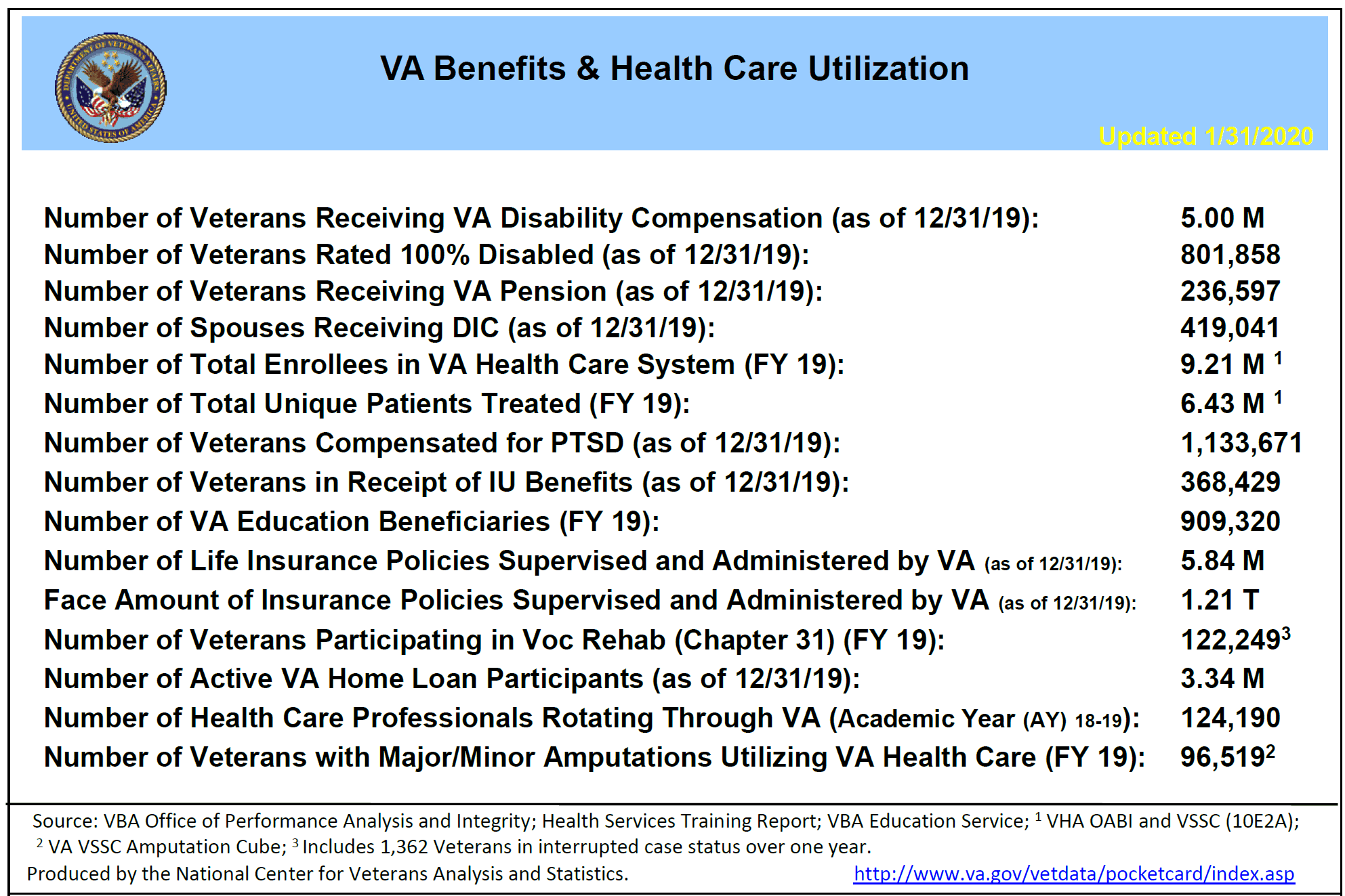Veteran Statistics in the United States – The Complete Guide
We analyzed 19,349,382 Veterans in the United States with the goal of understanding various Veteran statistics, to include Veteran populations and demographics by State.
We also looked at the 2019 data overall regarding the total Veteran population in the United States, which is currently 19.3M Veterans but slowly declining.
Digging in deeper, we wanted to know about Veteran Statistics to include those receiving some sort of service connected VA disability compensation benefits from the VA.
We also did our own internal study of 1,012 Veterans with a VA disability rating of 0% or higher, with the goal of understanding why they did not pursue VA disability compensation benefits earlier.
With the help of the Veterans Benefits Administration (VBA) FY 2018 Annual Report to Congress, the National Center for Veterans Analysis and Statistics, the U.S. Census Bureau, and our own internal study of 1,012 Disabled Veterans, we uncovered some very interesting findings.
And now it’s time to share what we discovered!
Veteran Statistics: Summary of Our Key Findings
- According to the National Center for Veterans Analysis and Statistics, the total Veteran population is set to decline from 20.8 million in 2015 to 12.0 million by 2045. The total annual change is -1.8%.
- Overall, the Veteran population is slowly declining, and will reach a low of 12.0 million by 2045.

- California was the #1 state for veterans in 2020, but Texas will overtake California for the top spot by 2027.
- In 2020, the Top 10 States where Veterans live are California, Texas, Florida, Pennsylvania, New York, Ohio, Virginia, North Carolina, Georgia, and Illinois.
- Roughly 50% of all Veterans live in one of the Top 10 Most Veteran Friendly States, mainly in the Southwestern and Eastern regions of the United States.
- A total of 5,560,085 Veterans out of an eligible 19,349,382 Veterans or 28.7% of Veterans alive today in the United States currently have a service connected VA disability rating of 0% or higher.
- According to Veteran Statistics, a total of 13,789,286 Veterans out of an eligible 19,349,382 Veterans or 71.3% of Veterans do NOT have any type of service connected VA rating, meaning they either haven’t applied for VA disability benefits or were denied in the past and gave up.
- In our study of 1,012 Veterans Statistics with a service connected VA rating of 0% or higher, the top two reasons why they didn’t apply for VA benefits earlier are, #1: 29% of Veterans said they didn’t feel like they deserved VA benefits because other Veterans have it worse off and #2: 27.3% said they weren’t educated about the VA claim process and didn’t even know they could apply (or didn’t know HOW to apply).
- 880 out of 1,012 Veterans (87%) said they do not think they currently have the VA disability rating they deserve by law (and think they deserve an increase).
Veteran Statistics By State – 2019 Data Analysis
| State | Total Veteran Population By State | Percentage of Veterans Living Below Poverty Line | Number of Veterans with a Disability Rating by State | Number of Veterans with a Disability Rating of 0% or Higher | Median Personal Income |
| California | 1,693,602 | 7.7% | 474,209 | 28.0% | $41,329 |
| Texas | 1,496,724 | 6.5% | 426,566 | 28.5% | $39,862 |
| Florida | 1,461,722 | 7.6% | 425,361 | 29.1% | $35,218 |
| Pennsylvania | 821,624 | 6.8% | 232,520 | 28.3% | $33,605 |
| New York | 773,063 | 6.6% | 221,869 | 28.7% | $36,747 |
| Ohio | 759,737 | 7.1% | 218,804 | 28.8% | $33,523 |
| Virginia | 690,427 | 5.5% | 146,371 | 21.2% | $50,267 |
| North Carolina | 673,384 | 7.7% | 193,935 | 28.8% | $35,517 |
| Georgia | 651,283 | 7.4% | 176,498 | 27.1% | $37,474 |
| Illinois | 639,445 | 7.2% | 177,766 | 27.8% | $37,588 |
| Michigan | 600,135 | 7.9% | 178,240 | 29.7% | $34,136 |
| Washington | 558,895 | 7.3% | 155,932 | 27.9% | $41,998 |
| Arizona | 483,026 | 7.6% | 144,425 | 29.9% | $36,161 |
| Tennessee | 450,313 | 8.9% | 142,749 | 31.7% | $33,122 |
| Missouri | 438,287 | 8.3% | 136,746 | 31.2% | $32,953 |
| Indiana | 408,790 | 7.5% | 129,586 | 31.7% | $32,576 |
| Maryland | 384,882 | 5.3% | 82,750 | 21.5% | $49,811 |
| Colorado | 377,992 | 6.9% | 99,412 | 26.3% | $40,927 |
| Wisconsin | 368,281 | 6.6% | 98,699 | 26.8% | $33,978 |
| South Carolina | 368,017 | 7.5% | 105,621 | 28.7% | $35,313 |
| New Jersey | 360,415 | 5.4% | 101,637 | 28.2% | $41,881 |
| Alabama | 344,304 | 8.6% | 111,554 | 32.4% | $35,573 |
| Massachusetts | 338,287 | 6.4% | 95,735 | 28.3% | $39,125 |
| Minnesota | 322,421 | 5.6% | 90,278 | 28.0% | $37,221 |
| Oregon | 295,348 | 8.0% | 100,123 | 33.9% | $33,532 |
| Kentucky | 280,030 | 8.8% | 94,930 | 33.9% | $31,989 |
| Oklahoma | 276,695 | 7.8% | 97,397 | 35.2% | $36,600 |
| Louisiana | 261,722 | 9.7% | 78,778 | 30.1% | $32,779 |
| Nevada | 212,314 | 7.8% | 61,996 | 29.2% | $35,354 |
| Arkansas | 207,886 | 8.6% | 70,265 | 33.8% | $31,822 |
| Iowa | 198,627 | 5.9% | 54,027 | 27.2% | $35,039 |
| Connecticut | 189,056 | 4.6% | 49,722 | 26.3% | $41,412 |
| Kansas | 187,113 | 6.2% | 54,450 | 29.1% | $36,185 |
| Mississippi | 174,500 | 9.4% | 56,538 | 32.4% | $31,853 |
| New Mexico | 152,055 | 8.7% | 46,833 | 30.8% | $37,082 |
| West Virginia | 140,755 | 9.0% | 48,701 | 34.6% | $31,632 |
| Utah | 131,381 | 6.6% | 37,838 | 28.8% | $41,257 |
| Nebraska | 127,730 | 6.3% | 35,764 | 28.0% | $37,398 |
| Idaho | 115,951 | 8.6% | 35,713 | 30.8% | $31,591 |
| Maine | 113,958 | 6.2% | 35,327 | 31.0% | $32,098 |
| Hawaii | 109,871 | 6.3% | 24,831 | 22.6% | $45,518 |
| New Hampshire | 99,552 | 5.5% | 27,974 | 28.1% | $39,498 |
| Puerto Rico | 89,665 | 19.9% | 37,928 | 42.3% | $19,585 |
| Montana | 84,496 | 8.1% | 25,095 | 29.7% | $33,877 |
| Delaware | 72,017 | 4.9% | 16,708 | 23.2% | $41,224 |
| Alaska | 69,848 | 4.3% | 17,462 | 25.0% | $51,060 |
| Rhode Island | 63,726 | 8.3% | 19,500 | 30.6% | $35,220 |
| South Dakota | 62,645 | 10.0% | 19,169 | 30.6% | $36,129 |
| North Dakota | 50,185 | 5.5% | 12,496 | 24.9% | $41,297 |
| Wyoming | 45,420 | 6.3% | 12,581 | 27.7% | $36,973 |
| Vermont | 43,725 | 6.0% | 13,074 | 29.9% | $33,564 |
| District of Columbia | 28,055 | 12.1% | 7,603 | 27.1% | $49,419 |
| TOTAL | 19,349,382 | 7.5% | 5,560,085 | 29.1% | $37,056 |
Top 10 States for Veterans – by Veteran population

- #1 California – 1,693,602 Veterans
- #2 Texas – 1,496,724 Veterans
- #3 Florida – 1,461,722 Veterans
- #4 Pennsylvania – 821,624 Veterans
- #5 New York – 773,063 Veterans
- #6 Ohio – 759,737 Veterans
- #7 Virginia – 690,427 Veterans
- #8 North Carolina – 673,384 Veterans
- #9 Georgia – 651,283 Veterans
- #10 Illinois – 639,445 Veterans
Top 12 Veteran Reported Reasons Why They Do Not Have the VA Disability Benefits Deserved by Law
We asked 1,012 Disabled Veterans with a VA disability rating of 0% or higher about the primary reasons why they are stuck, frustrated, and underrated by the VA.
Of the Top 5 reported reasons, “Mindset” was the #1 overall reason, meaning Veterans mistakenly believe they don’t deserve VA benefits, or that if they get benefits it will negatively impact other Veterans who need them more.
The other Top 4 reported reasons have to do with “Lack of Education” about the VA claim process, meaning, Veterans don’t know what they don’t know.
- “I didn’t think I deserved VA disability benefits because other Veterans are worse off than me (the lies we tell ourselves).”
- “I didn’t know I could file for a VA disability increase or add secondary claims, so I didn’t even try (wasn’t educated about the process).”
- “I wish I knew back then that I should have went to the clinic and documented my injuries. A lot easier to prove your case.”
- “I tried before and got denied so I quit.”
- “I didn’t know VA disability compensation benefits existed until I left the military.”
- “I filed for an increase and added new disabilities with my VA representative, and they didn’t know how to properly file the paperwork.”
- “C&P examiners were dismissive, condescending, and discouraging.”
- “I knew I could file for an increase but didn’t know “HOW” to do it, so I never finished the process.”
- “VA doctors are not helpful. Wouldn’t help with Medical Nexus Letters or DBQs.”
- “My Veterans Claims Representative discouraged me and did not provide any help or guidance. In fact, they didn’t even know what I could apply for.”
- “I was scared to tamper with my original rating for fear of a decrease in my VA benefits.”
- “I did not think, or was told, that I did not have enough medical/written proof of my disabilities.”
- “Told by my VSO that if I wasn’t treated for issue during military service I couldn’t file.”
VA Benefits and VA Healthcare Statistics

About the Author
Brian Reese is a VA disability expert, author, and founder of VA Claims Insider – “The Most Trusted Name in Education-Based Resources for Veterans.”
More than 300,000 military members and veterans come to the VA Claims Insider and Military Disability Made Easy websites each month to get educated on the VA and DoD disability process.
Learn more >> About VA Claims Insider HERE. <<
Brian’s frustration with the 8-step VA disability claims process led him to create “VA Claims Insider,” which provides disabled veterans with tips, strategies, and lessons learned to win their VA disability compensation claim in less time.

He is also the CEO of Military Disability Made Easy, which is the world’s largest free searchable database for all things related to DoD disability and VA disability, and has served more than 6,000,000 military members and veterans since its founding in 2013.
Veterans can download one of his #1 most downloaded FREE eBooks right here right now: “The Secret Guide to 833 Ratable VA Disabilities” by clicking HERE now.
Brian is a former active duty Air Force officer with extensive experience leading hundreds of individuals and multi-functional teams in challenging international environments, including a combat tour to southern Afghanistan in 2011 in support of Operation ENDURING FREEDOM.
Brian is a Distinguished Graduate of Management from the United States Air Force Academy, Colorado Springs, CO and he holds an MBA from Oklahoma State University’s Spears School of Business, Stillwater, OK, where he was a National Honor Scholar (Top 1% of Graduate School class).
